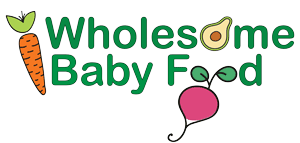Pumpkins For Baby – Feeding Baby Pumpkin and Making Pumpking For Baby Food

Pumpkins ( and squash in general) are actually fruits. Many of us think of pumpkin as a fruit so pumpkin is on the Veggie and the Fruits pages. A pumpkin is a type of squash and is a member of the gourd family (Cucurbitacae). This family also includes squash, cucumbers, gherkins, and melons.
You can mix pumpkin with cereals, veggie purees, with meat purees and use them in teething biscuit recipes, in healthy cake recipes, in yogurt and mixed with other fruits also.
When Can Babies Eat Pumpkin? When To Introduce Pumpkin to Babies
Babies can eat Pumpkins from 6 months old. Pumpkin is also a good first food for babies too. Feed your baby plain cooked pumpkin, in pureed form. Mix pumpkin puree into homemade cereals, with other fruits and vegetables, in yogurts, and even in meats such as chicken. Adding a dash of cinnamon to pumpkin gives baby a first exposure to the wonder of spices.
You may also bake pumpkin as you would a butternut or acorn squash and serve the baked pumpkin in small dices as Baby Finger Foods. Rub a wee bit of butter and a bit of cinnamon on the inside of the pumpkin prior to baking for a tasty nutritious treat.
Like with other fruits and veggies like avocados and apples, pumpkin mixes well with almost any food you can think of. Try pureeing pumpkin with apples, pears, with avocado or sweet potatoes or even peaches and yogurt.
Are Pumpkins Good For Babies To Eat? What Are The Health and Nutritional Benefits of Pumpkins?
The Nutritional Goodness of Pumpkin
|
PUMPKIN: (one cup – cooked)
|
|
| VITAMINS: Vitamin A – 12230 IU Vitamin C – 11.5 mg Vitamin K – 2.0 Folate (important during pregnancy) – 22 mcg Niacin – 1.01 mg |
MINERALS: Potassium – 364 mg Phosphorus – 74 mg Magnesium – 22 mg Calcium – 37 mg Sodium – 2 mg Iron – 1.40 mg Also contains trace amounts of zinc, manganese and copper. |
Pumpkins are packed with delicious nutrition. They are loaded with Vitamin A and beta carotene. Beta Carotene is one of the plant carotenoids that when eaten and digested, turns into Vitamin A in the human body.
Pumpkins are also good sources of potassium, protein, and iron. The seeds of the pumpkin contain a good amount of protein and iron so eating the seeds does provide some nutritive value. We don’t recommend that you offer your baby or toddler pumpkin seeds however. Pumpkins are wonderfully low in fat, low in calories but high in fiber.
How To Choose A Pumpkin For Eating And Baby Food Making
Jack-o-Lantern pumpkins are NOT a good pumpkin choice for making any food dish or for making baby’s food. Sugar or “baking” or “pie” pumpkins should be used in food dishes. These smaller pumpkins are more tender and less stringy than the larger variety. Try to find a pumpkin anywhere between five to eight pounds. The smaller, sugar/pie pumpkins provide the most flavorful additions to any baked dish or baked good and are great as a soup.
Always thoroughly wash any pumpkin that you will be using for food!
What Is The Best Way To Cook or Prepare Pumpkins For Babies?
Pumpkins may be roasted, slow cooked, poached, boiled, steamed or baked. Please be aware that Pumpkins tend to loose nutritional value with prolonged cooking. Roasting or baking pumpkins for (food dishes and) homemade baby food will ensure the most nutrients are retained for your baby.
A pumpkin must be cooked immediately after you have cut it open or you will find a brownish-blackish mold begin to into the flesh.
Once cooked, use the pumpkin immediately or chill it. If you will not be using the cooked pumpkin immediately, store it either pureed or in the cooked chunks, in the freezer. Pumpkindoes freeze well. Cooked pumpkin will turn a brownish orange so don’t be alarmed when you peak into the bowl and find that color.
Roasting and baking pumpkins, as with many other fruits/squashes may be the best choice of cooking for optimal flavor and nutrient retention. Slow cooking pumpkins is also a great way to prepare pumpkin and to retain nutrients.
Stringy Pumpkin?
When scooping out the “meat” of many winter squash types, you may encounter some very hard “strings”. These strings are actually the veins of the shell. Look at the acorn squash or sugar pumpkin and notice it’s ridges. Between these ridges are the “veins” or strings that you may find once you have cut and then baked the squash or pumpkin. Check out the Is your pumpkin or winter squash puree plagued with hard strings?
Pumpkin Recipes For Baby Food And More
